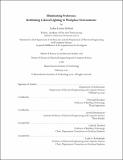| dc.contributor.advisor | Christoph Reinhart. | en_US |
| dc.contributor.author | Lesina Debiasi, Lukas. | en_US |
| dc.contributor.other | Massachusetts Institute of Technology. Department of Architecture. | en_US |
| dc.contributor.other | Massachusetts Institute of Technology. Department of Electrical Engineering and Computer Science. | en_US |
| dc.date.accessioned | 2021-03-22T17:05:25Z | |
| dc.date.available | 2021-03-22T17:05:25Z | |
| dc.date.copyright | 2020 | en_US |
| dc.date.issued | 2020 | en_US |
| dc.identifier.uri | https://hdl.handle.net/1721.1/130183 | |
| dc.description | Thesis: S.M., Massachusetts Institute of Technology, Department of Architecture, September, 2020 | en_US |
| dc.description | Thesis: S.M., Massachusetts Institute of Technology, Department of Electrical Engineering and Computer Science, September, 2020 | en_US |
| dc.description | Cataloged from student-submitted PDF of thesis. "February 2020." Confirmed by MIT Registrar Office, graduation date is September 2020. | en_US |
| dc.description | Includes bibliographical references (pages 69-71). | en_US |
| dc.description.abstract | Comfort in workspace lighting is hard to define. In recent years "smart hardware" has enabled personalized control in lighting. Provided interfaces, however are often forcibly tying the ephemeral nature of light and personal preference into a simplified interface. In this thesis, three new paradigms are proposed, emphasizing on personalization through sensing and matching preferred light to a given workplace task. Firstly a study attempts to find correlations between semiotic meaning and task on different media trying to establish pipeline for interaction. In a second example, the experience itself becomes the most essential part and is thus framed around the question, to whether sufficient knowledge of preference can be matched to nearby workplaces through methods oflearning. Thirdly in a personalized lighting setup, a microcontroller, equipped with a camera, uses image recognition algorithms tracking movement and pose of people in the room adjusting lighting condition to suit a given task. In summary, this thesis poses the question: how can personalized lighting rethought, to better allow for tasks in workplace environments? | en_US |
| dc.description.statementofresponsibility | by Lukas Lesina Debiasi. | en_US |
| dc.format.extent | 75 pages | en_US |
| dc.language.iso | eng | en_US |
| dc.publisher | Massachusetts Institute of Technology | en_US |
| dc.rights | MIT theses may be protected by copyright. Please reuse MIT thesis content according to the MIT Libraries Permissions Policy, which is available through the URL provided. | en_US |
| dc.rights.uri | http://dspace.mit.edu/handle/1721.1/7582 | en_US |
| dc.subject | Architecture. | en_US |
| dc.subject | Electrical Engineering and Computer Science. | en_US |
| dc.title | Illuminating preference : rethinking colored lighting in workplace environments | en_US |
| dc.title.alternative | Rethinking colored lighting in workplace environments | en_US |
| dc.type | Thesis | en_US |
| dc.description.degree | S.M. | en_US |
| dc.description.degree | S.M. | en_US |
| dc.contributor.department | Massachusetts Institute of Technology. Department of Architecture | en_US |
| dc.contributor.department | Massachusetts Institute of Technology. Department of Electrical Engineering and Computer Science | en_US |
| dc.identifier.oclc | 1241081636 | en_US |
| dc.description.collection | S.M. Massachusetts Institute of Technology, Department of Architecture | en_US |
| dc.description.collection | S.M. Massachusetts Institute of Technology, Department of Electrical Engineering and Computer Science | en_US |
| dspace.imported | 2021-03-22T17:04:52Z | en_US |
| mit.thesis.degree | Master | en_US |
| mit.thesis.department | Arch | en_US |
| mit.thesis.department | EECS | en_US |
